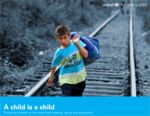A child is a child: Protecting children on the move from violence, abuse and exploitation

This report documents the nature and frequency of violations of children’s rights in the context of displacement. In 2015, there were 10 million child refugees and 1 million asylum seekers worldwide. The proportion of migrants displaced by conflict has been growing in the past few decades; in 2005, about 1 in every 350 children was a refugee. In 2015, the figure was 1 in 200. And children accounted for half of the world’s refugees. The report is full of maps, charts and quotations from child migrants, as well as explanatory text, all of which seek to unravel children’s current migration patterns.
A child is a child makes for some difficult reading. It details the extent to which children are not only fleeing conflict (as in Syria) and violence (as in Honduras), but are also encountering violence and abuse in their flight. Smuggling can turn into trafficking, and the conditions of children’s passage can include forced work, captivity, extortion, beatings, and sexual assault.
Yet the violence for which smugglers are responsible is only part of the picture. Governments of destination countries, with their restrictive or dehumanizing policies, such as detention, are also partly culpable for the continued suffering of children on the move.
The report also points out that while child migrants are vulnerable overall, relative to adults, certain groups of children face particular risks. These include unaccompanied children, girls, and children with disabilities.
UNICEF’s recommendations are six-fold:
1) Protect children from exploitation and violence, by expanding safe, legal mechanisms for children’s mobility
2) Stop detaining displaced children, by turning to family, community or individual solutions instead
3) Keep children documented and with their families, by issuing legal status and reuniting families if separated
4) Promote displaced children’s health and schooling, by providing basic services
5) Address the causes of displacement, by tackling violence and poverty in origin communities
6) Fight discrimination and xenophobia, by creating more welcoming policies at both governmental and civil society levels
The report stresses the urgency of these needs, given that (page 7):
Children’s rights are not confined by national borders. Where conflict or disaster, neglect, abuse or marginalization drive children to move, their rights move with them. Leadership is urgently required to forge global agreement on how to protect and guarantee the rights of children as they move, no matter who or where they are.
Available from:
https://www.unicef.org/publications/index_95956.html
Further reading:
Cummins, Deborah and Sarah Moharram (2017), “Aid in context: the importance of market-based approaches to aid delivery in northern Syria”, Briefing, International Institute for Environment and Development, 4 pages, available at http://pubs.iied.org/17424IIED/?k=urban.
Halabi, Zeina (2004), “Exclusion and identity in Lebanon’s Palestinian refugee camps: a story of sustained conflict”, Environment and Urbanization Vol 16, No 2, pages 39–48, available at http://journals.sagepub.com/doi/pdf/10.1177/095624780401600221.
Mann, Gillian (2002), “ ‘Wakimbizi, wakimbizi’: Congolese refugee boys’ and girls perspectives on life in Dar es Salaam, Tanzania”, Environment and Urbanization Vol 14, No 2, pages 115–122, available at http://journals.sagepub.com/doi/pdf/10.1177/095624780201400209.
Book note prepared by Christine Ro
Search the Book notes database
Our Book notes database contains details and summaries of all the publications included in Book notes since 1993 - with details on how to obtain/download.
Use the search form above, or visit the Book notes landing page for more options and latest content.
For a searchable database for papers in Environment and Urbanization, go to http://eau.sagepub.com/

